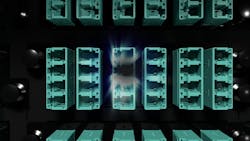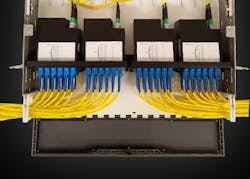Legrand bills new Infinium Quantum as 'lowest loss' optical fiber system for data centers
Per a statement from the company, "Available in both single-mode and multimode versions, the patent-pending Infinium Quantum systems offer the lowest channel link loss at 0.75dB, which is a recorded 64% improvement over standard systems and a 38% improvement over any ultra low-loss optical fiber system available on the market."
According to the manufacturer, Infinium Quantum, which now becomes Legrand’s premium optical fiber system, was exclusively designed to allow the fastest and most reliable migration path to 400G and beyond by reducing or eliminating the need to replace cabling components. The Infinium Quantum system can be configured for 8-, 12- or 24-fiber connectivity for all Ethernet system options utilizing Base-8 or Base-12, depending on the specific IEEE 802.3 standard for 100Gb/s, 200Gb/s or 400Gb/s transmission.
As noted by Legrand's statement, "Reliability of any optical fiber system is dependent on the link loss budget, which combines the total of connector loss with the cable loss. The loss budget has two uses: 1) during the design stage to ensure the cabling plant will work with the links intended to be used over it; and, 2) after installation, the loss budget is compared to the calculated loss to test results to ensure the cable plant is installed properly."
“With higher speeds and higher bandwidths, the total link loss budget tolerances are becoming tighter and the overall component losses are becoming smaller," adds Randy Harris, Senior Product Manager at Legrand. "Understanding the relationship between total component loss and its effects on the entire network performance allows a system designer to implement a reliable cabling infrastructure for current and future needs and provides flexibility to support new technologies and architectures by simply updating the transceivers. The Infinium Quantum system is based on a combination of superior engineering and unique patent-pending manufacturing processes of each of the connectivity components, which include high-density enclosures and panels, cassettes, trunk cable assemblies and patch cords,” states Harris.
Legrand notes that the TIA-568.3-D standard allows a multimode connector loss to a maximum of 0.75dB each. However, typical multimode connectors have losses of 0.2-0.5dB; factory-made and fusion-spliced single-mode connectors have losses of 0.1-0.2dB; and field terminated single-mode connectors have losses ranging from 0.5-1.0dB.
“Introducing a fiber system with a loss of four connections for a combined total channel loss of .75dB is revolutionary in our industry and this becomes increasingly critical for evolving data centers, such as hyperscale environments,” Legrand's Harris further contends. "Any additional loss will depend on the specific fiber type and link distance."
Harris continues, "In addition, the Infinium Quantum provides additional energy savings – up to 30% — based on the transceiver power consumption. A key factor in the lower loss and energy savings is the design of angled multimode connectivity for high-bandwidth transceiver transmission. Typically single-mode systems employ angled connectors but with today’s VCSEL transceivers, which are required for high-bandwidth multimode systems, these generate more heat, which can create additional back reflections. Therefore, the multimode angled solution ultimately provides better optical return loss performance. The Infinium Quantum’s single-mode total channel connection return loss is -55dB and the multimode system return loss is -34dB. Some of the high-end transceivers are tunable at the output level and if there is a better performing system the power can be turned down, which directly correlates with electricity savings, making the Infinium Quantum system more sustainable, too,” he concludes.
To learn more about Legrand's Infinium Quantum system, visit: https://www.legrand.us/markets-solutions/data-center-solutions/infinium-quantum-fiber-solutions.aspx.

